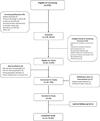A Depression Prevention Intervention for Adolescents in the Emergency Department
- PMID: 27267141
- PMCID: PMC5035565
- DOI: 10.1016/j.jadohealth.2016.04.008
A Depression Prevention Intervention for Adolescents in the Emergency Department
Abstract
Purpose: To evaluate acceptability and feasibility of a theoretically based two-part (brief in-person + 8-week automated text message) depression prevention program, "intervention for DepressiOn and Violence prevention in the Emergency department" (iDOVE), for high-risk adolescents.
Methods: English-speaking emergency department (ED) patients (age 13-17, any chief complaint) were sequentially approached for consent on a convenience sample of shifts and screened for inclusion based on current depressive symptoms and past-year violence. After consent, baseline assessments were obtained; all participants were enrolled in the two-part intervention (brief in-ED + 8-week two-way text messaging). At 8 weeks, quantitative and qualitative follow-up assessments were obtained. Measures included feasibility, acceptability, and preliminary data on efficacy. Qualitative data were transcribed verbatim, double coded, and interpreted using thematic analysis. Quantitative results were analyzed descriptively and with paired t tests.
Results: As planned, 16 participants (eight each gender) were recruited (75% of those who were eligible; 66% nonwhite, 63% low income, mean age 15.4). The intervention had high feasibility and acceptability: 93.8% completed 8-week follow-up; 80% of daily text messages received responses; 31% of participants requested ≥1 "on-demand" text message. In-person and text message portions were rated as good/excellent by 87%. Qualitatively, participants articulated: (1) iDOVE was welcome and helpful, if unexpected in the ED; (2) the daily text message mood assessment was "most important"; (3) content was "uplifting"; and (4) balancing intervention "relatability" and automation was challenging. Participants' mean ΔBDI-2 (Beck Depression Inventory) from baseline to 8-week follow-up was -4.9, (p = .02).
Conclusions: This automated preventive text message intervention is acceptable and feasible. Qualitative data emphasize the importance of creating positive, relevant, and interactive digital health tools for adolescents.
Keywords: Adolescents; Behavior change; Depression; Health promotion; Mixed methods; Text messaging.
Copyright © 2016 Society for Adolescent Health and Medicine. Published by Elsevier Inc. All rights reserved.
Figures
Comment in
-
Expanding Adolescent Depression Prevention Through Simple Communication Technologies.J Adolesc Health. 2016 Oct;59(4):373-4. doi: 10.1016/j.jadohealth.2016.07.016. J Adolesc Health. 2016. PMID: 27664464 Free PMC article. No abstract available.
References
-
- Wilson KM, Klein JD. Adolescents who use the emergency department as their usual source of care. Arch Pediatr Adolesc Med. 2000;154:361–365. - PubMed
MeSH terms
Grants and funding
LinkOut - more resources
Full Text Sources
Other Literature Sources
Medical
Research Materials
Miscellaneous



